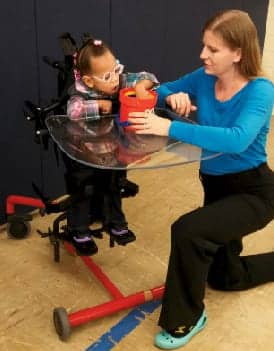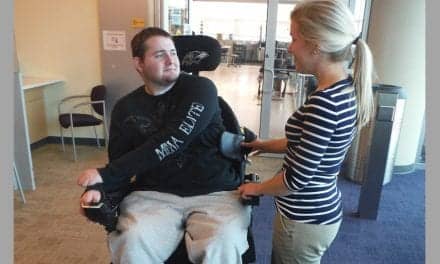Blending stander use with adjunct treatments targets the reduction of joint contractures’ impact on independent mobility.
by Stephenie Labandz, PT, DPT
Joint contractures occur when tissues around the joints that are usually pliable become replaced by more fibrous and less mobile tissue due to disuse or an underlying disease process. Contracture often has a negative impact on range of motion and function, and may be accompanied by pain, which may decrease motivation to work toward correcting the contracture.1 Children affected by mobility-limiting neuromuscular issues such as cerebral palsy (CP) are at increased risk for joint contractures because of prolonged periods of minimal movement in a limited array of positions. When dystonia, or repetitive involuntary contraction of a muscle group,2 is added to immobility, the effect is compounded. Formation of contractures further decreases the level of function and independence attainable by the individual.
Managing range of motion and contributing factors such as spasticity at an early age is essential because of the rapid growth and skeletal pliability in young children’s bodies. Persistent, abnormal forces can effectively mold the body into abnormal alignment. Hip dysplasia, tibial and femoral torsion, and scoliosis may result. The long-term effects may include pain, disability, and impaired cardiorespiratory function.
Many approaches are being used to provide more movement and more positioning options, and decrease abnormal muscle tone, for improved long-term outcomes and overall function. Standing frame use has been shown to be effective in itself and is also easily combined with other pharmacologic, surgical, therapy, and educational interventions to decrease the effects of abnormal muscle tone and limit the impact of joint contractures on those at risk.3-7
As is frequently the case, prevention is the best medicine.
Standing, Contractures, and Spasticity
Standing is a conservative, noninvasive, and cost-effective approach to managing spasticity and joint contractures, with many pediatric stander models costing around $2,000.8 The costs of the other tone-inhibiting interventions addressed in this article may quickly add up to greater sums, as they involve multiple office visits or hospitalization with highly specialized surgery and involved follow-up care. It is a good place to begin as a preventive measure for children with spasticity and limited mobility around the first birthday—when same-age peers are beginning to stand, cruise, and walk—provided there is approval from the medical team, and orthotics for assistance with alignment if indicated.
In an experimental design by Tremblay et al,7 12 children with CP stood on a tilt table for 30 minutes, with measurements of torque EMG taken before and after intervention. These results were then compared to those from a control group of 10 children with CP kept at rest. The children who had stood had statistically significant decreases in spasticity, which lasted up to 35 minutes after intervention.
Standing frames are manufactured in a variety of styles that may help inhibit tone or address problem areas. In a child whose body is generally affected by a pattern of extensor tone, where the head pushes back as the spine extends, the shoulders retract, and the limbs extend backward, placing them in a prone standing position helps break that reflexive tone pattern. This provides a more functional position conducive to effective alignment and stretching. Conversely, a child with a high degree of flexor tone experiences less impact of flexors while reclined, and would likely achieve better results in supine standing.9 For those with significant joint contractures difficult to accommodate on typical supine or prone standers, sit-to-stand standers support the affected joint and allow for gradual progression of joint angle.
Even with early and consistent intervention, standing may not be enough to effectively reduce spasticity and maintain joint motion. Singer et al6 identified the presence of dystonia as one of the greatest limiting factors in whether passive standing alone is effective in the reduction of contractures.
Significant progress has been made since the 1990s in what constitutes typical orthopedic intervention for individuals with CP. Hagglund et al10 describe the emergence of three tone-inhibiting techniques that have had great impact in reducing the need for orthopedic surgery for the prevention of contracture or skeletal torsion deformity in nonambulatory children with spasticity and dystonia. They are selective dorsal rhizotomy, continuous intrathecal baclofen infusion, and botulinum toxin treatment. Each intervention acts to interrupt the abnormal messages being sent to muscles from the central nervous system.
Of a group of Swedish children with CP born 1990 to 1991, 40% required surgery to correct significant skeletal alignment issues, such as tibial and femoral derotation osteotomies, by age 8 years. In Swedish children with cerebral palsy born 1994 to 1995, the proportion requiring similar surgical intervention was only 15% at their eighth year. This is presumably at least in part due to the growing availability and use of these tone-inhibiting treatments. While selective dorsal rhizotomy and intrathecal baclofen pump placement are major surgical undertakings, they can help prevent the prolonged forces on the musculoskeletal system that cause torsion and deformity that may limit function and require invasive, multiple-level orthopedic procedures in the future.
Standing and Botulinum Toxin
Botulinum toxin (Botox) is a protein that, when injected intramuscularly, attaches permanently to the presynaptic nerve membrane and prevents the release of the neurotransmitter acetylcholine, effectively preventing contraction of the targeted muscle.11 The effects last approximately 3 months, because the body is able to adapt by sprouting new neurons to re-establish impulse transmission, at which time the procedure may be repeated. Calf muscles, hamstrings, and hip flexors are common lower extremity sights targeted. The toxin generally requires 24 to 72 hours to take effect,12 during which time a physician may recommend a period of rest. Once return to normal activity is approved, the muscle should be stretched frequently for prolonged periods to effect a change by lengthening the muscle fibers once the abnormal stimulus has been removed. Finding a functional way to maintain a calf stretch, hamstring stretch, or hip stretch for prolonged periods may be challenging for a patient or caregivers. Bracing and casting are sometimes used to hold a desired position, and the addition of body weight in standing helps maximize the stretch. The duration of the stretch in a stander may be 30 to 60 minutes, multiple times per day as tolerated, while the person standing may simultaneously participate in other exercises or functional activities of daily living. This does not replace the home exercise program, but presents a far more practical way to maintain a prolonged stretch position for an improved outcome.
Standing and Selective Dorsal Rhizotomy
Selective dorsal rhizotomy is a neurological surgical procedure by which the surgeon accesses the dorsal column of the spinal cord, electrically stimulates a nerve to determine the resulting motor response, and then cuts the nerves that elicit abnormal or undesirable movements. The goal is to remove abnormal inputs while maintaining enough nervous input and strength for improved body alignment and mobility. This procedure involves removing six to eight lamina from the spinal column and severing between 14% and 50% of the nerve roots.11
Postoperative weakness is common, as several nerves and muscles are effectively deactivated. Intensive and ongoing long-term physical therapy that includes standing and weight-bearing activity is recognized as essential following this procedure. Standing as early as safely possible is important to allow muscles to lengthen and joints to stretch in desirable alignment once the abnormal motor input has been removed. It is not unusual for children to experience decreased endurance from surgery and the requisite postoperative activity limitations for about 1 month. A standing frame allows them to spend far more time upright than they are able under their own power. It also helps a child to develop a new motor plan for what upright standing in good alignment feels like. Protecting the surgical site is essential early in recovery, and a stander allows for work on progressive trunk stabilization while controlling the available planes and degrees of motion.
Standing and Intrathecal Baclofen
Gamma-aminobutyric acid (GABA) is one of the nervous system’s primary inhibitory transmitters. Baclofen is a drug that acts as a GABA antagonist, also causing an inhibitory effect on the central nervous system. Baclofen is available and used as an oral drug, but has limited effectiveness on the central nervous system because it does not cross the blood-brain barrier efficiently.11 However, when the drug can be administered directly into the cerebrospinal fluid, it effectively acts to inhibit hypertonia. This is achieved by placement of a catheter into the tissue sheath that contains the spinal cord, or the intrathecal space. A constant dose of baclofen is then delivered from a small, circular, refillable pump about 3½ inches in diameter and approximately ¾ inch thick that is surgically implanted beneath the abdominal skin or fascia.13 The pump must be refilled at least every 6 months, and as often as monthly, depending on the dose and the size of the reservoir. The pump itself is replaced every 5 to 7 years.
A comprehensive assessment takes place before a pump is placed to determine whether the presence of baclofen acting on the nervous system results in functional gains. Despite all the negative impacts it can have, some spasticity is functional, as individuals learn to rely on the stability provided by their muscle tone to help with transfers and mobility. Underlying weakness is frequently “unmasked” by removing the spasticity.
Stander use can help with lengthening muscles once abnormal motor messages from the nervous system have been inhibited. An individual’s sense of where their joints and body are oriented in space may be altered, so supported standing is a valuable early step in postoperative motor learning. A stander allows the individual to feel the sensation of upright standing alignment and to practice weight shifting and work toward greater core stability in a secure-feeling fall-free situation.
Stretching Forward
Standing frames are one of the valuable therapeutic tools available to manage hypertonia and minimize the risk of and help reverse the debilitating effects of joint contractures. They are affordable and easily incorporated into activities of daily living, other tone-inhibiting interventions, and therapeutic activities to yield optimal outcomes for individuals with dystonia. RM
Stephenie Labandz, PT, DPT, received her Master of Physical Therapy and Doctor of Physical Therapy degrees from the College of St. Catherine in Minneapolis. She currently works for Robbinsdale Area Schools in Minnesota, serving children and families through the Early Intervention and Early Childhood Special Education programs. For more information, contact [email protected].
References
1. Vorvick L. Contracture Deformity, MedlinePlus website, National Institutes of Health. http://www.nlm.nih.gov/medlineplus/ency/article/003185.htm Updated August 14, 2012. Accessed September 8, 2013.
2. Mayo Clinic. Dystonia. http://www.mayoclinic.com/health/dystonia/DS00684 Updated May 12, 2012. Accessed September 8, 2013.
3. Baker K. Therapeutic standing for people with multiple sclerosis: efficacy and feasibility. Int J Ther Rehabil. 2007;14:104–109.
4. Eng JJ, Levins SM, Townson AF, MahJones D, Bremner J, Huston G. Use of prolonged standing for individuals with spinal cord injuries. Phys Ther. 2001;81:1392–1399.
5. Richardson DLA. The use of the tilt table to effect passive tendoAchilles stretch in a patient with head injury. Physio Theory Prac. 1991;7:45–50.
6. Singer BJ, Dunne JW, Singer KP, Jegasothy GM, Allison GT. Nonsurgical management of ankle contracture following acquired brain injury. Dis Rehabil. 2003;26:335–345.
7. Tremblay F, Malouin F, Richards CL, Dumas F. Effects of prolonged muscle stretch on reflex and voluntary muscle activations in children with spastic cerebral palsy. Scand J Rehabil Med. 1990;22:171–180.
8. Adaptivemall.com. Standers. Accessed September 8, 2013.
9. Davies PM. Steps to Follow: The Comprehensive Treatment of Patients with Hemiplegia. New York: Springer-Verlag; 2000:71.
10. Hagglund G, Andersson S, Duppe H, Lauge-Pedersen HL, Nordmark E, Westbom L. Prevention of severe contractures might replace multilevel surgery in cerebral palsy: results of a population-based health care programme and new techniques to reduce spasticity. J Pediatr Orthop B. 2005;14:269-273.
11. Spasticity in children and young people with non-progressive brain disorders: management of spasticity and co-existing motor disorders and their early musculoskeletal complications, NICE Clinical Guidelines, No. 145, National Collaborating Centre for Women’s and Children’s Health (UK). London: RCOG Press; July 2012.
12. Nigam PK, Nigam A. Botulinum toxin. Indian J Dermatol. 2010; 55:8–14.
13. Medtronic. Synchomed II infusion pump: features and specifications. http://professional.medtronic.com/pt/neuro/itb/prod/synchromed-ii/features-specifications/index.htm#.Uizkv9LMDeI. Accessed September 8, 2013.






